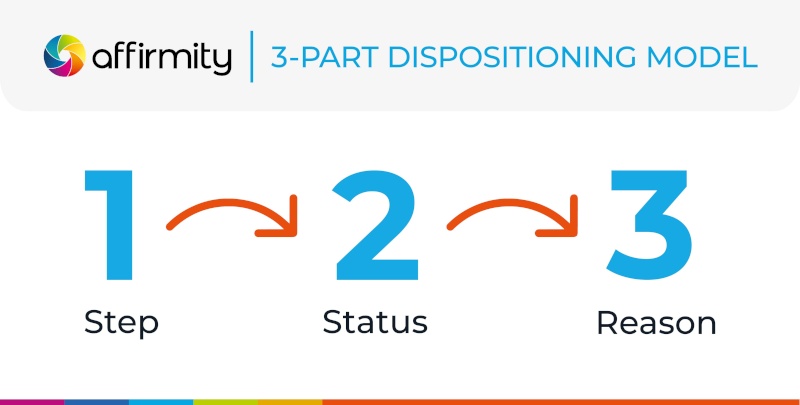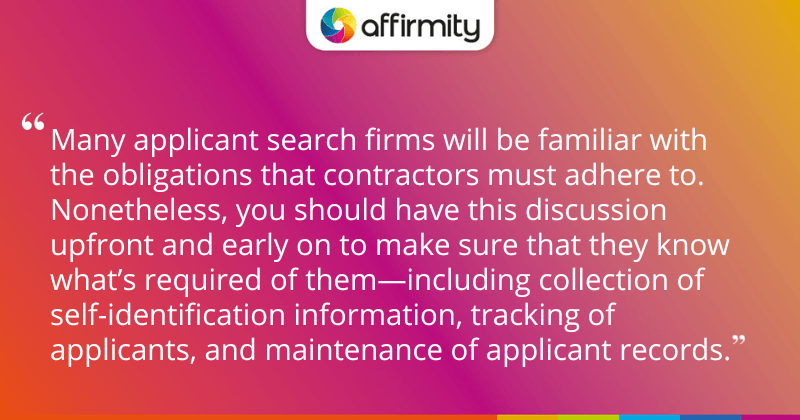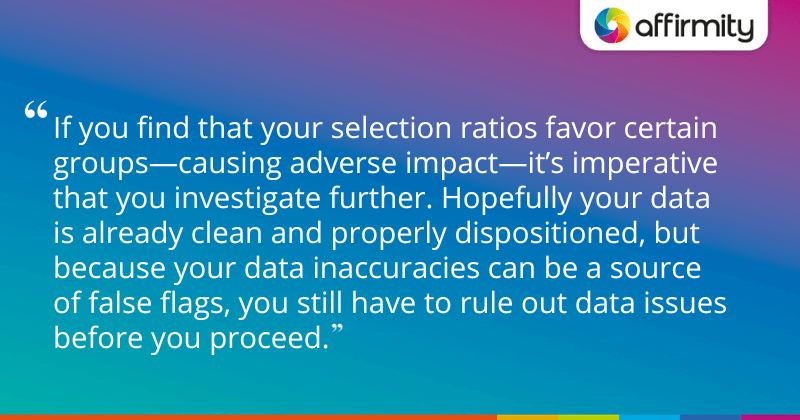Are you confident that if you were selected for an OFCCP audit tomorrow, that your applicant data would prove your hiring practices to be non-discriminatory? And do you know the full extent of what your data is telling you? In this blog post, Affirmity’s director of consulting services Mauri Spears looks at the warning signs that suggest your applicant data may not measure up. She also considers how to best collect and prepare your data to become completely audit-ready.
Reviewing the compliance of your applicant processes remains one of the cornerstone tasks of OFCCP audit preparedness, yet applicant record-keeping violations are among the most common issues uncovered when the OFCCP conducts its investigations. To comply, an organization must:
- Document its applicant processes
- Review the diversity of its applicant pools
- Track its hiring practices
- Take action that is proactive rather than reactive
- Identify adverse impact, work to understand the causes, and mitigate them
- Train those involved in the hiring process
The OFCCP expects to be able to compare the selection rates for those who applied against those who were selected, requiring that your data pools for applicants and hires are accurate and match up. Applicant data can be tricky to work with. It’s often maintained separately from employee data and passes through many more people—recruiters, hiring managers, and other key figures contribute to these records, requiring more comprehensive training efforts and leaving more room for user error.
These complexities aren’t insurmountable by any means, and though a complete list of potential errors is outside the scope of this article, we’ve pulled together some of the most common indicators that your applicant data will need more work if it’s to be made audit ready.
1) Applicants Are Not Properly Dispositioned
Improperly dispositioned candidates are probably the most common and consistently large-scale error that Affirmity’s consultants see in applicant data. Disposition data records the status of an application when an employer interacts with it. This data may fall short when a disposition isn’t recorded, is recorded incorrectly, or if too vague a record is kept.

The model Affirmity typically recommends is to describe three key areas when dispositioning: the step, status, and reason. This model allows you to record enough detail about the sometimes complex picture that emerges as people move through the process. For example, you may need to record that:
- A candidate was disqualified at the manager review phase for not meeting the minimum requirements
- A candidate withdrew from consideration at the recruiter review stage because they could not work the required shift pattern
Getting stakeholders to provide an accurate and timely disposition is essential—timeliness is particularly worth emphasizing, as it’s often much harder to recall what happened weeks or months after the fact.
Dispositioning is important because auditors need to be able to understand where and why someone fell out of the process. It’s also important in the event that you need to perform a steps analysis while investigating and counteracting adverse impact.
MORE FROM THE BLOG | ‘How to Fairly and Safely Handle RIFs and Furloughs in an Economic Downturn’
2) You’re Creating Inconsistencies With How You Pull and Pool Data
Applicant data issues aren’t solely about the data you put into your Applicant Tracking System (ATS). You also need to take care to pull applicants correctly out of the system. There are certain aspects of your logic that will need to be checked. A good example is that if a position runs from June 1 to June 30, you can potentially miss entries in your system if you only pull records with an application date in the month of June—it’s not unusual to consider people who applied prior to the hiring window. Rather you’d want to consider pulling via requisition instead.
Here are similar checks to consider when making sure you’re including the accurate pool for your selection rates:
- Ensuring there’s an applicant record for each hire. Sometimes if the person is a rehire, or hired through a search firm, their data may not be in your ATS.
- Cross-referencing your applicants with dispositions of “Hired” to ensure there’s a corresponding hire record in your HRIS. Absent records could be future hires, or an example of inaccurate dispositioning.
- Checking all dispositions to ensure they meet the Internet Applicant Definition.
- Checking for instances of 1:1 applicant-to-hire ratio and being prepared to explain why this has occurred.
- Ensuring requisitions are assigned to a single job title. Requisitions that result in hires in various locations and across job titles can greatly increase the complexity of data reconciliation.
GET A ROBUST APPROACH TO PAY EQUITY DATA | ‘6 Pay Equity Analysis Software Features That Simplify Your Process’

3) Your Third-Party Recruiting Partners Aren’t Fully up to Speed
Your organization may rely on third parties in your recruiting process for any number of valid reasons. Nonetheless, it’s essential that you choose third parties that understand and adhere to your applicant data policies and procedures with minimal disruption to your OFCCP obligations.
Many applicant search firms will be familiar with the obligations that contractors must adhere to. Nonetheless, you should have this discussion upfront and early on to make sure that they know what’s required of them—including collection of self identification information, tracking of applicants, and maintenance of applicant records. Remember, when it comes to the burden of proof at audit time, the buck stops with the contractor, not their third parties. Choose partners that are able and willing to work with applicants, and applicant data, to your requirements.
OFCCP INSIGHTS TO READ TODAY | ‘10 Key Insights From the OFCCP and EEOC at the National Industry Liaison Group Conference 2022’

4) You Aren’t Working to Anticipate the OFCCP’s Findings
Your compliance is expected to be proactive rather than merely reactive as a general principle. Your audit preparedness partly depends on your ability to identify the areas the OFCCP is likely to query, and to describe and prove how you’re already working to address those areas.
For example, in the event of an audit, you’ll be submitting your counts for applicants and hires, and the OFCCP will use these to conduct an impact ratio analysis. This will compare the selection rates for personnel activity like hires, promotions, and terminations between favored and unfavored groups, highlighting areas for further investigation. Naturally, you can and should be running these analyses ahead of time.
If you find that your selection ratios favor certain groups—causing adverse impact—it’s imperative that you investigate further. Hopefully your data is already clean and properly dispositioned, but because your data inaccuracies can be a source of false flags, you still have to rule out data issues before you proceed. Once you’re confident that your data is clean and adverse impact still exists, you can start work on identifying why and how to correct it.
Typically, adverse impact is investigated using a steps analysis, which will tell you where certain groups are falling out of the hiring process. In the best-case scenario, your early identification of adverse impact will allow you to remove the problem before an auditor ever sees it.
LEARN MORE ABOUT ADVERSE IMPACT | ‘OFCCP Compliance Series: How to Mitigate Adverse Impact By Reviewing Employee Selection Processes’
We can help you ensure your data is audit-ready—and take your data collection practice beyond simple compliance. Contact us to find out more.
 About the Author
About the Author
Mauri Spears is the Director of Consulting Services at Affirmity. Since 1997, she has served clients by providing leadership in workforce compliance, DE&I, and training management. In her current role, she manages Affirmity’s software implementations and training, services, and leads the data analytics team. Connect with her on LinkedIn.
